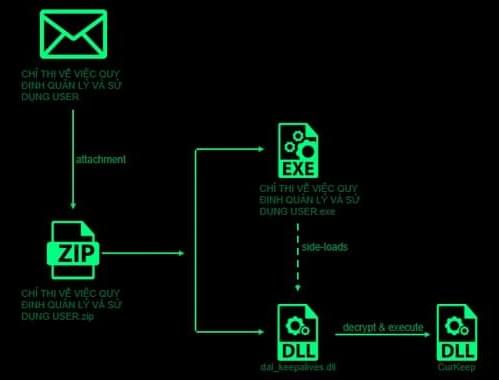Cybersecurity experts uncover an ongoing threat to government and telecom entities in Asia. Learn how a campaign named “Stayin’ Alive” is deploying #malware.
Check out the details:


⚡ Beware of the HTTP/2 Rapid Reset attack!
A novel zero-day flaw is being exploited to launch record-breaking distributed #DDoS attacks.
Find out more here: https://thehackernews.com/2023/10/http2-rapid-reset-zero-day.html.
Learn how AWS, Cloudflare, and Google are addressing CVE-2023–44487.

https://informatech.co/3RVp6BM by Elizabeth Montalbano.
Attackers are employing a new type of certificate abuse in an attempt to spread info-stealing malware, with the aim of collecting credentials and other sensitive data. In some instances, the goal is to steal cryptocurrency from Windows systems.
The campaign uses search engine optimization (SEO) poisoning to deliver search results featuring malicious pages promoting illegal software cracks and downloads. In the background, the pages deliver remote access Trojans (RATs) known as LummaC2, and RecordBreaker (aka Raccoon Stealer V2) researchers from South Korea-based AhnLab revealed in a blog post on Oct. 10.
Notably, the malware uses abnormal certificates featuring Subject Name and Issuer Name fields that have unusually long strings, which means they require specific tools or infrastructure to inspect the certificates and are not visible in Windows systems. Specifically, the signature strings include Arabic, Japanese, and other non-English languages, along with special characters and punctuation marks, diverging from the typical English character string structures, the researchers noted.

After a researcher discovered that an Android TV streaming box, known as T95, was infected with preloaded malware, researchers at Human Security released information regarding the extent of infected devices and how malicious schemes are connected to these corrupted products.
Daniel Milisic, a systems security consultant, created a script alongside instructions to help other users mitigate the threat after first coming across the issue. Now, Human Security’s threat intelligence and research team has dubbed the operation “Bandbox,” which it characterizes as a complex, interconnected series of ad fraud schemes on a massive scale.
Human Security describes the operation as “a global network of consumer products with firmware backdoors installed and sold through a normal hardware supply chain.” Once activated, the malware on the devices connect to a command-and-control (C2) server for further instructions. In tandem, a botnet known as Peachpit is integrated with Badbox, and engages in ad fraud, residential proxy services, fake email/messaging accounts, and unauthorized remote code installation.

FS-ISAC executive shares tips on operational resilience in the face of cyber threats. #cyberattacks
Preparing for the unexpected may be a contradiction in terms, but for financial firms it is essential for survival. The sector has long been a target for threat actors, given that this is where the world’s money is. And as the financial ecosystem becomes increasingly interconnected, threats to its security and resilience are rapidly evolving and increasing.
Operational resilience is not just about responding with agility to risks but also maintaining continuity of operations with minimal or — even better — no disruptions. So, whereas cybersecurity is about preventing and defending against cyberattacks, resilience focuses on sustaining operations despite attacks.
Recognizing the necessity of operational resilience, regulators are emphasizing the need to be prepared for unforeseen incidents. A prominent example is the EU’s Digital Operational Resilience Act (DORA), which provides a framework for the finance industry to detect, prevent, contain, and recover from attacks associated with information and communication technology (ICT).

After an early flurry of exploit activity, attacks targeting a maximum-severity flaw that Progress Software disclosed in its WS_FTP Server file transfer product last week appear to have been somewhat limited so far.
However, that’s no reason for organizations to delay patching the vulnerability as soon as possible, given how widely attackers exploited a similarly critical zero-day flaw that Progress reported in its MOVEit file transfer software in May.
CVE-2023–40044 is a. NET deserialization vulnerability in WS_FTP that researchers have shown can be exploited with a single HTTPS POST and some specific multi-part data. Progress disclosed the bug on Sept. 27, with a recommendation for organizations to apply the company’s update for it as soon as possible.

23andMe, the popular DNA testing company, has launched an investigation after client information was listed for sale on a cybercrime forum this week.
On Oct. 1, a post was published on the forum with a link to a sample of allegedly “20 million pieces of data” from the genetic testing company, claiming that it was “the most valuable data you’ll ever see.” The first leak included 1 million lines of data, but on Oct. 4, the threat actor began offering bulk data profiles ranging from $1 to $10 per account in batches of 100, 1,000, 10,000, and 100,000 profiles.
The information leaked in the breach includes names, usernames, profile photos, gender, birthdays, geographical location, and genetic ancestry results.

Artificial intelligence (AI) and emerging technologies have ushered in a new era, bringing unprecedented opportunities and challenges. In today’s rapidly evolving digital landscape, addressing these multifaceted challenges necessitates a collaborative effort spanning various sectors and calls for policy reforms while emphasizing global cooperation.
The rapid advancement of technologies, particularly artificial intelligence, has introduced transformative possibilities alongside a range of concerns. While AI holds the potential to revolutionize industries and enhance our daily lives, it also raises pressing issues related to data privacy, misinformation, and cybersecurity.
Experts have proposed adopting the “information environment” framework to address these multifaceted challenges. This framework comprises three essential components:

The — a crucial mission as AI capabilities are increasingly acquired, developed and integrated into U.S. defense and intelligence systems, the agency’s outgoing director announced Thursday.
Army Gen. Paul Nakasone said the center would be incorporated into the NSA’s Cybersecurity Collaboration Center, where it works with private industry and international partners to harden the U.S. defense-industrial base against threats from adversaries led by China and Russia.
“We maintain an advantage in AI in the United States today. That AI advantage should not be taken for granted,” Nakasone said at the National Press Club, emphasizing the threat from Beijing in particular.”
The National Security Agency is starting an artificial intelligence security center — a crucial mission as AI capabilities are increasingly acquired, developed and integrated into U.S. defense and intelligence systems.

This is a risky bet, given the limitations of the technology. Tech companies have not solved some of the persistent problems with AI language models, such as their propensity to make things up or “hallucinate.” But what concerns me the most is that they are a security and privacy disaster, as I wrote earlier this year. Tech companies are putting this deeply flawed tech in the hands of millions of people and allowing AI models access to sensitive information such as their emails, calendars, and private messages. In doing so, they are making us all vulnerable to scams, phishing, and hacks on a massive scale.
I’ve covered the significant security problems with AI language models before. Now that AI assistants have access to personal information and can simultaneously browse the web, they are particularly prone to a type of attack called indirect prompt injection. It’s ridiculously easy to execute, and there is no known fix.
In an indirect prompt injection attack, a third party “alters a website by adding hidden text that is meant to change the AI’s behavior,” as I wrote in April. “Attackers could use social media or email to direct users to websites with these secret prompts. Once that happens, the AI system could be manipulated to let the attacker try to extract people’s credit card information, for example.” With this new generation of AI models plugged into social media and emails, the opportunities for hackers are endless.